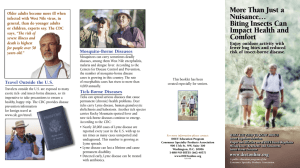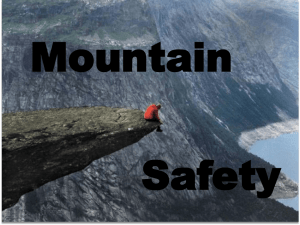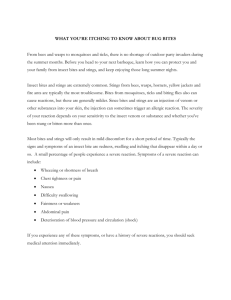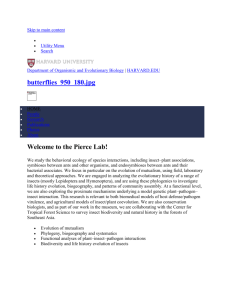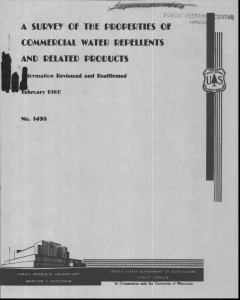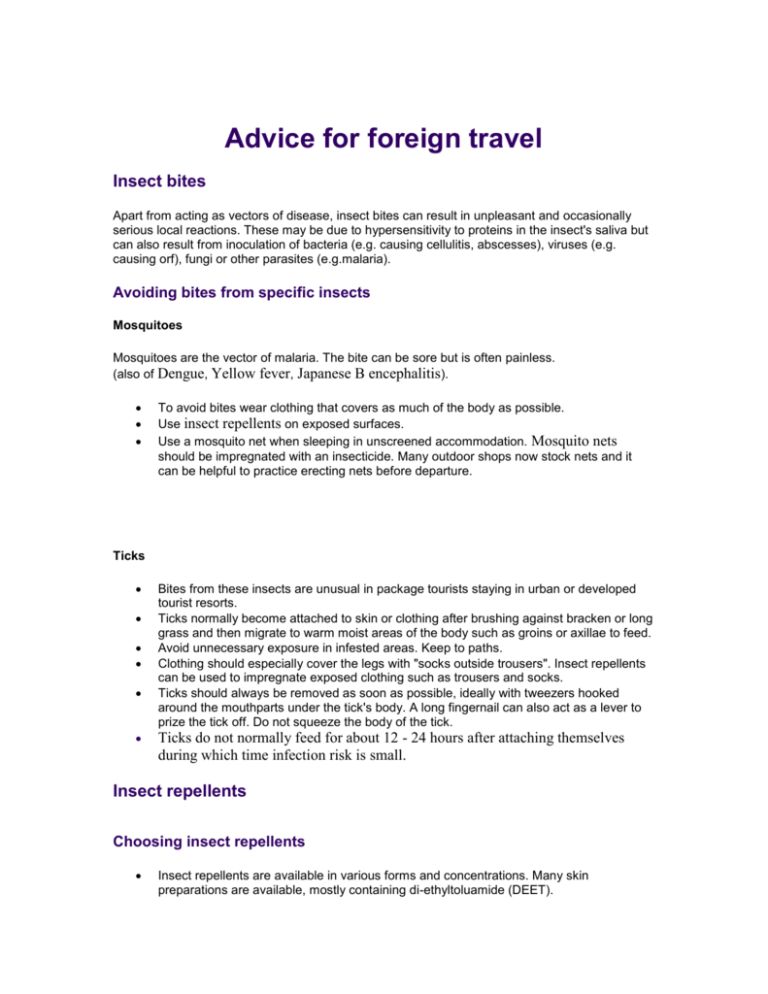
Advice for foreign travel
Insect bites
Apart from acting as vectors of disease, insect bites can result in unpleasant and occasionally
serious local reactions. These may be due to hypersensitivity to proteins in the insect's saliva but
can also result from inoculation of bacteria (e.g. causing cellulitis, abscesses), viruses (e.g.
causing orf), fungi or other parasites (e.g.malaria).
Avoiding bites from specific insects
Mosquitoes
Mosquitoes are the vector of malaria. The bite can be sore but is often painless.
(also of Dengue, Yellow fever, Japanese B encephalitis).
To avoid bites wear clothing that covers as much of the body as possible.
Use insect repellents on exposed surfaces.
Use a mosquito net when sleeping in unscreened accommodation. Mosquito nets
should be impregnated with an insecticide. Many outdoor shops now stock nets and it
can be helpful to practice erecting nets before departure.
Ticks
Bites from these insects are unusual in package tourists staying in urban or developed
tourist resorts.
Ticks normally become attached to skin or clothing after brushing against bracken or long
grass and then migrate to warm moist areas of the body such as groins or axillae to feed.
Avoid unnecessary exposure in infested areas. Keep to paths.
Clothing should especially cover the legs with "socks outside trousers". Insect repellents
can be used to impregnate exposed clothing such as trousers and socks.
Ticks should always be removed as soon as possible, ideally with tweezers hooked
around the mouthparts under the tick's body. A long fingernail can also act as a lever to
prize the tick off. Do not squeeze the body of the tick.
Ticks do not normally feed for about 12 - 24 hours after attaching themselves
during which time infection risk is small.
Insect repellents
Choosing insect repellents
Insect repellents are available in various forms and concentrations. Many skin
preparations are available, mostly containing di-ethyltoluamide (DEET).
DEET concentrations of around 30% are thought to be suitable for skin and stronger
concenrations can be used on clothing.
For those allergic to DEET, alternatives include Dimethyl Pthalate (contained in 'shoo') or
Lemon Eucalyptus oil (contained in 'Mosiguard').
Aerosol and pump-spray products are available which are suitable for treating clothing - if
aerosols and pump sprays are used on skin it is best to spray liquid onto your hand and
then rub onto exposed areas.
Liquid, creams, lotions and sticks are designed for skin application.
Using insect repellents safely
Clothes are the best protection - normally only use repellents on the remaining exposed
areas of skin and shirt collars and cuffs and the ankle bottoms of trousers or slacks.
Repellants can damage plastics which may, for example, be used on watches and in
contact lenses.
Mosquitoes can bite skin through skin-tight clothes - it is always best to wear loose fitting
garments.
Never use repellents over cuts, wounds, or irritated skin.
Don't apply to eyes and mouth, and apply sparingly around ears. When using sprays do
not spray directly onto the face; spray on hands first and then apply to face.
Do not allow young children to handle repellents - they may get them into their eyes.
Apply to your own hands and to the child's skin.
Use just enough repellent to cover exposed skin. Heavy application is unnecessary.
After use, wash treated skin. This is particularly important when repellents are
used repeatedly.
If you suspect that you or your children are reacting to an insect repellent,
discontinue use, wash treated skin and then contact your doctor.
Availability of Mosquito Nets (which should be impregnated with insecticide)
(Impregnation with deltamethrin gives longer protection than impregnation with
permethrin)
On-line suppliers include:
HOMEWAY MEDICAL: www.travelwithcare.co.uk
MASTA: http://www.masta.org/travel-shop/index.asp
NOMAD: http://www.nomadtravel.co.uk
SAFA: www.safa.co.uk
SAFARIQUIP: www.safariquip.co.uk
TISO: http://www.tiso.co.uk
WorldWideNets: http://www.worldwidenets.co.uk/
Travellers' Diarrhoea
Remember loose motions can also result from a change in diet including, for example, spicy or
oily foods.
Prevention
This depends upon effective drinking water sterilization and ensuring food is uncontaminated or
cooked thoroughly. Personal hygiene when eating and drinking is also important including hand
washing prior to eating and using sterile plates, cups and utensils.
What to avoid
Water should only be drunk when you are sure of its purity. Don't drink it without boiling,
chemical disinfection or using a reliable filter. This also applies to water used for making
ice cubes and cleaning teeth. Bottled water is usually safe, as are hot tea and coffee,
beer and wine.
Milk should be boiled unless you are sure it has been pasteurised.
Cheeses and ice-cream are often made from unpasteurised milk and when in doubt
these should only be bought from larger well established companies when quality can
usually be assured.
Meat should be thoroughly cooked and eaten hot whenever possible. Avoid leftovers.
Fish and shellfish can be hazardous at certain times of year, even if well cooked. Take
local advice about seafood, but when in doubt it is best to avoid them.
Vegetables should only be eaten when thoroughly cooked.
Green salads should be avoided.
Fruit should be peeled, including tomatoes.
Wash hands thoroughly before eating or handling food, and always after using the toilet.
Vaccination
No licensed vaccines are available in the UK against travellers' diarrhoea
Treatment
The priority in treatment is preventing dehydration especially in young children. Clear fluids such
as diluted fruit juices or ideally specially prepared oral rehydrating solutions such as dioralyte
(bought at the chemist) should be drunk liberally. All these preparations must be prepared with
sterile water. Anti-diarrhoea agents such as loperamide (Imodium®) or diphenoxylate plus
atropine (lomotil®) should be used sparingly - they can help particularly with associated colicky
pains. Overuse can cause 'rebound' constipation and occasionally encourage other complications
such as septicaemia. A course of motilium (bought over the counter) is useful to have if there is
associated nausea and vomiting.
Blood and mucous suggests campylobacter, shigella or amoebic infection. Marked vomiting,
fever, pain, bleeding or dehydration usually require hospital referral so the intravenous fluids can
be administered.
Health risks from the sun
Sun damage to the skin
Although sunbathing may be enjoyable and a suntan a status symbol, it must be remembered
that excessive sun exposure is a health hazard due to the effect of ultraviolet (UV) radiation on
the skin.
UVB causes sunburn which can range from intense erythema to blistering and 'burnt skin' similar
to a burn from hot water or fire. Sunburn is more likely when, in addition to direct exposure from
the sun, UV is also 'reflected' from water (swimming pools or the sea), white sand or snow. The
risk is greater at higher altitudes when there is less protection from the earth's atmosphere.
Both ultraviolet A (UVA) and ultraviolet B (UVB) radiation are known to cause pre-mature
cancers. Drying of skin can result in exacerbation of facial seborrhoeic dermatitis.
Especially vulnerable groups
Babies and children.
Fair skinned people who often also have red hair or blue eyes.
Those with certain medical conditions such as albinism or previous skin cancer.
Those medications such as tetracyclines including doxycycline, oral hypoglycaemic drugs
and diuretics.
Precautions
Babies under 9 months should be kept out of direct sunlight.
Children should wear long sleeved, loose fitting shirts, hats and high-factor sunscreen.
The greatest risk is from the midday sun, usually from noon until 14.00 hours (15.00 in
tropical regions) when precautions are especially important.
Adults should wear a broad brimmed hat, long sleeved shirts and sunglasses.
Sunscreens
Sunscreens do not replace the precautions described above but they can help absorb
UVB and to a lesser extent UVA.
Waterproof sunscreens can prevent their removal by sweat or water although they should
always be reapplied after swimming.
There is a voluntary star system for sunscreens grading UVA protection; more stars
indicating greater protection.
The Sun Protection Factor (SPF) refers to the protection against UVB (e.g. 'SPF 8' allows
approximately 8 times longer sun exposure without burning than with no protection).
To gain effective protection a cream with an SPF value of 15 or above should be used.
Sunscreens are expensive - be wary of cheap sunscreens bought abroad which may not
give adequate protection.
Check expiry dates.
Sexually Transmitted Infections
Penetrative sexual intercourse is the most common way in which sexually transmitted infections
are transmitted. Diseases occurring as a result are known as sexually transmitted diseases. They
can also be transmitted during oral sex and skin-to-skin contact in the genital or anal areas.
Genital ulcers and mucosal damage often associated with discharge, increase the risk of
transmission of HIV. Some infections can be fatal or cause long term morbidity (e.g. hepatitis B
and HIV ) including infertility (e.g. gonorrhoea and chlamydia).
The risk
Casual sexual relationships, particularly without the use of barrier protection, are always
risky. Commercial sex workers (prostitutes) frequently have very high rates of infection.
In some countries commercial sex is very common and even encouraged, and exposure
to 'propositioning and even harassment' is common. The unprepared traveller may be
taken unawares and end up taking risks which would not be normal behaviour at home.
Infections may be asymptomatic but not non-infectious so they may be transmitted,
unknowingly to subsequent partners and spouses.
The use of recreational drugs and alcohol, can lead the traveller into risky sexual
behaviour.
Some of the more common diseases
(All these infections can be symptomless and no vaccines are available)
HIV/AIDS (Human Immunodeficiency virus)
Gonorrhoea (Neisseria gonorrhoea)
Chlamydia (Chlamydia trachomatis)Syphilis (Treponema pallidum)
Herpes (Herpes Simplex)
Genital warts (Human papilloma virus)
Advice for Travellers
Confining sexual activities to one non-infected partner is the most effective means of prevention.
This is however frequently not widespread practice even in countries where this behaviour is
generally seen as the social and religious 'norm', particularly by those who are put under peer
and other social or occupational pressure to behave otherwise.
Safer Sex (Condoms)
Using good quality impermeable condoms with any casual or potentially infected partner
is essential. Remember it is the barrier that protects against STIs, not spermicides
contained within them.
Remember you won’t always know who is infected!
Check expiry dates and only buy from a reputable source.
It is important to bear in mind that while condoms will dramatically reduce the
possibility of transmission of most infections they are not 100% effective.
Blood transfusions
Advice for travellers
Blood transfusion should only be accepted when absolutely necessary.
If pregnant or suffering from medical condition which may lead to heavy blood loss,
travelling to countries with poor medical services may need to be reconsidered.
Knowing your blood group in advance may make it easier to find a blood donor in an
emergency. Joining organisations, such as the Blood Care Foundation, who can help to
supply safe blood is emergency situations, might be considered.
Many developing countries reuse syringes and needles. Commercially prepared travel
packs are readily available from many pharmacists, travel clinics, as well as outdoor
stores, for use in an emergency. They should be supplied with a certificate showing
contents and the reason for its purchase for customs clearance. Experience has shown
that these packs are very rarely used and unless the traveller is going to be in very
remote areas, away from cities, it should normally be possible to ensure that sterile
equipment is used by any local medical attendants.

